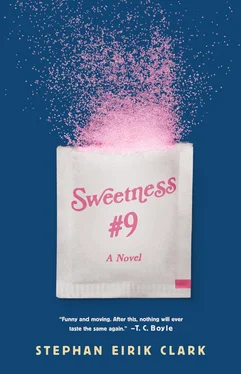Pipes flushed overhead, hair dryers roared and fell silent, and then the kids came shuffling in with all the grace of the undead. Ernest, now twelve and dressed in blue satin shorts and a white youth soccer jersey, got the step-stool out and poured himself a bowl of cereal before joining me at the table. Priscilla, meanwhile, stood before the open mouth of the refrigerator long enough to affect the temperature in the room. Finally, she took a grapefruit half-veiled in Saran Wrap to the counter and began carving into it with a serrated spoon. Her first bite showed that while she was sixteen years old, there was nothing sweet about this age. Turning a sour face to me, she asked, “Is this in season?”
“Pardon?” I couldn’t remember the last time I’d heard the question. “I don’t think we have those anymore.”
“What do you mean?”
I knew of vast warehouses where apples were kept in a state of suspended animation, the temperature and oxygen levels there so low that, with the right chemical spray and a good seal of wax, a Golden Delicious or a Granny Smith could be picked in August of one year and sold at your local grocery store in December of the next. I assumed the same was true for grapefruit, but suspected my daughter would not look upon this as evidence of progress and new ideas. She had taken that halved grapefruit into her hand and was staring down at it as if she were Hamlet up on stage with Yorick’s skull.
“Try some sugar,” I said.
She went into the cupboards and a few seconds later said that we were out.
“There’s plenty of sweetener,” Betty answered, as she came down the stairs drinking from a can of diet cola. “Should be with the tea,” she said, blurring past us into the pantry, her skin giving off a warm glow thanks to the twenty-five minutes she’d spent on the elliptical.
Priscilla found the one hundred — count box of white packets that Betty had purchased to make her rare cup of Lipton palatable, then shook the tiniest amount of white granules over her sour fruit.
Ernest sat across from me, reading a manual for a new computer game while he ate. His bowl of sugar cereal had transformed since it had come tumbling out of the box in the colors of our flag. Now, through some process of modern alchemy, the milk dribbled down my son’s chin blue blue blue. He looked up from his bowl, feeling my attention upon him. I looked to the remains of the breakfast sandwich I’d pushed between us.
“Done?” he said.
I shrugged and nodded. He fell in on The Manwich with all the ferocity of a scavenger.
Churchill once spoke of Russia as a riddle wrapped in a mystery inside an enigma; if I were to speak of Ernest in a similar way, I might describe him as a corn dog wrapped in a slice of pizza stuffed inside a Hot Pocket. I couldn’t explain it. The boy ate like a ravenous dog, but still he had been the smallest child in his most recent class photo, smaller even than Duc and Hung Jackson, the two roly-poly Vietnamese boys who’d been adopted by a black, gay Vietnam vet and profiled in the local paper. More than once I’d watched my son eat a bucket of fried chicken or a second frozen pizza, only to see him stand in his underwear on the scale in the bathroom and show the same weight as the previous month. Was there something wrong with him? I’d been asking the question since he’d been diagnosed at six months with what our pediatrician had called “failure to thrive” (and Betty had translated to mean “failure to mother,” in part because she’d refused to breast-feed him after suffering through Priscilla’s ministrations on her inverted nipple). I had tried to maintain a positive attitude about him through the years, but it had become harder and harder to keep that up as I sat with him in my lap and watched as one ham-fisted nurse after another drew a vial of blood from his arm. To date, we had ruled out celiac disease (three times), gluten sensitivity (twice), and even irritable bowel syndrome. Just a month or two previously, we had taken him to Children’s Hospital in Battle Station, where the latest specialist had snaked a tube down his throat and come out into the recovery room to tell us it didn’t look like he had a tumor or GERD or even a misshapen esophagus. We left that day knowing as much as we had known at six months, which was nothing in the form of a question. Was there something wrong with him?
As my son ate, I picked up the box that my breakfast sandwich had come in and read the list of ingredients on the side. Sure enough, on the third line, placed inside parentheses listing the components of the vegetable shortening, there it was: “beta carotene [color], Sweetness #9, and natural and artificial flavors.”
Ernest turned the sandwich round in his hand and began eating at it from a new angle.
I heard a man’s voice then — a strained and throaty rasp that sent my eyes over to Priscilla, who had pushed up on her toes to turn on the little yellow radio that sat on top of the fridge. The radio had belonged to Aspirina, but after our housekeeper died the previous summer (a bus accident that made the local news), we forgot to point it out to her nephews when they came over to claim her things. Now, when Priscilla wasn’t forcing us to listen to “world music,” she was spinning the tuner to the far left end of the AM dial, where so many of the talk show hosts, like this one, sounded as if they’d been handcuffed to a chair.
“You don’t have to join the Widows of Sugar Hill or become a member of the Sweetness #9 Action Network,” the man said. “You want to do something? Get to know a guy like Jack Thompson in Madison, Wisconsin, who farms organic on two urban acres. It’s in seven thousand products, America! You think you’re safe? Buy your vegetables from a guy like Go Sun Tiak in Houston, Texas. Do you even know a farmer like Go Sun Tiak?” He spat the name as if it were a poisonous venom. “Shame on you, America! If the answer’s no, for shame!”
I sat there, my buttocks stiffened in my chair, thinking back on those days of happy jingles: Pour a little cheer in your life!
Betty reemerged from the pantry, stuffing two breakfast bars into her purse. Then she crossed to the fridge, stopping as she reached our daughter.
“Let me take you on a shopping spree,” she said.
Each day this summer Priscilla had worn the same thing: a black hooded sweatshirt, tan Ben Davis work pants, and a pair of red flat-footed sneakers that were no more technologically advanced than those I’d worn as a teenager. The outfit was so formless and unbecoming, it so thoroughly denied the existence of her changing body, that I feared my daughter had been sexually molested or heaven forbid raped. Betty assured me I was just worrying (“A mother knows,” she said) and dismissed the drabness of our daughter’s new wardrobe by saying it was only further evidence of “Priscilla being Priscilla.” Our daughter certainly was her own thing. She was a celebration of recessive genes — the one person in the family with freckles and attached ear-lobes, and with red hair that even Betty’s parents hadn’t been able to explain. The mystery was deepening, too. Ever since she’d quit the cheerleading squad the previous year and abandoned all of her old friends, I’d looked upon her with a mixture of fear and confusion, as if experiencing my first touch of Alzheimer’s and having trouble connecting a familiar face to a name.
Priscilla gave her mother’s outfit a quick once-over, saying she’d rather not look “like a first lady on parade.” Betty turned to me, visibly wounded. Just a few years earlier, she never would have left the house in the pink skirt-jacket combination she wore this morning. But the culture was undergoing a sea change (celebrities had started to appear on the covers of her “stupid magazines,” pushing strollers and holding babies against their hips), so she had reintroduced all the colors and styles that she’d embargoed during business school.
Читать дальше












